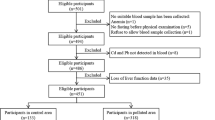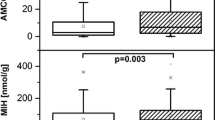Summary
To detect early hepatic effects of chronic exposure to low-level trichloroethylene (TCE), serum total cholesterol (T-C), high-density-lipoprotein cholesterol (HDL-C) and activities of three serum enzymes [aspartate aminotransferase (AST), alanine aminotransferase (ALT), and γ-glutamyl transpeptidase (GGT)] were determined in 148 workers (a cross-sectional study) and in 13 workers (a 2-year follow-up study) occupationally exposed to TCE in air. In the cross-sectional study, three exposure groups were defined by urinary total trichlorocompounds (U-TTC) levels of the workers [low-exposure group (n = 49) : U-TTC < 10 mg/g creatinine; moderate-exposure group (n = 56): U-TTC 10-<100; highexposure group (n = 43): U-TTC ≽ 100]. With increasing exposure levels, T-C (P = 0.143 by ANOVA) and HDL-C (P = 0.080 by ANOVA) slightly increased. The exposure, however, had no effect on the activities of the three serum enyzmes. In the follow-up study, the fluctuations in U-TTC were well reflected in subclinical changes in HDL-C, AST, and GGT, but not in T-C or ALT. These results suggest that exposure to low-level TCE influences hepatic functions, affecting cholesterol metabolism rather than causing hepatic cell damage, and that these influences are subclinical and reversible. The increases in HDL-C caused by exposure to low-level TCE may be an example of “chemical hormesis” in humans.
Similar content being viewed by others
References
Axelson O, Andersson K, Hogstedt C, Holmberg B, Molina G, Verdier A de (1978) A cohort study on trichloroethylene exposure and cancer mortality. J Occup Med 20: 194–196
Barret L, Faure J, Guilland B, Chomat D, Didier B, Debru JL (1984) Trichloroethylene occupational exposure: elements for better prevention. Int Arch Occup Environ Health 53:283–289
Bruckner JV, Davis BD, Blancato JN (1989) Metabolism, toxicity, and carcinogenicity of trichloroethylene. CRC Crit Rev Toxicol 20:31–50
Buben JA, O'Flaherty EJ (1985) Delineation of the role of metabolism in the hepatotoxicity of trichloroethylene and perchloroethylene: a dose-effect study. Toxicol Appl Pharmacol 78:105–122
Calabrese EJ, McCarthy ME, Kenyon E, (1987) The occurrence of chemically induced hormesis. Health Phys 52:531–541
Durrington PN (1982) High-density lipoprotein cholesterol: methods and clinical significance. CRC Crit Rev Clin Lab Sci 18:31–78
IARC (1979) Trichloroethylene. IARC Monogr Eval Carcinog Risks Chem Hum 20:545–572
Magara Y, Furuichi T (1986) Environmental pollution by trichloroethylene: a nationwide survey. Dev Toxicol Environ Sci 12:231–243
McCunney RJ (1988) Diverse manifestations of trichloroethylene. Br J Ind Med 45:122–126
Muller G, Spassowski M, Henschler D (1975) Metabolism of trichloroethylene in man. Ill. Interaction of trichloroethylene and ethanol. Arch Toxicol 33:173–189
Neafsey PJ (1990) Longevity hormesis. A review. Mech Ageing Dev 51:1–31
Nomiyama K (1971) Estimation of trichloroethylene exposure by biological materials. Int Arch Arbeitsmed 27:281–292
Plaa GL, Hewitt WR (1982) Quantitative evaluation of indices of hepatotoxicity. In: Plaa GL, Hewitt WR (eds) Toxicology of the liver. Raven, New York, pp 103–120
Shindell S, Ulrich S (1985) A cohort study of employees of a manufacturing plant using trichloroethylene. J Occup Med 27:577–579
Tanaka S, Ikeda M (1986) A method for determination of trichloroethanol and trichloroacetic acid in urine. Br J Ind Med 25:214–219
Tola S, Vilhunen R, Jarvinen E, Korkala M-L (1980) A cohort study on workers exposed to trichloroethylene. J Occup Med 22:737–740
Tominaga T (1992) Chlorofluorocarbons in the atmosphere: trends and vertical profiles. Pure Appl Chem 64:529–536
Author information
Authors and Affiliations
Rights and permissions
About this article
Cite this article
Nagaya, T., Ishikawa, N., Hata, H. et al. Subclinical and reversible hepatic effects of occupational exposure to trichloroethylene. Int. Arch Occup Environ Heath 64, 561–563 (1993). https://doi.org/10.1007/BF00517701
Received:
Accepted:
Issue Date:
DOI: https://doi.org/10.1007/BF00517701




